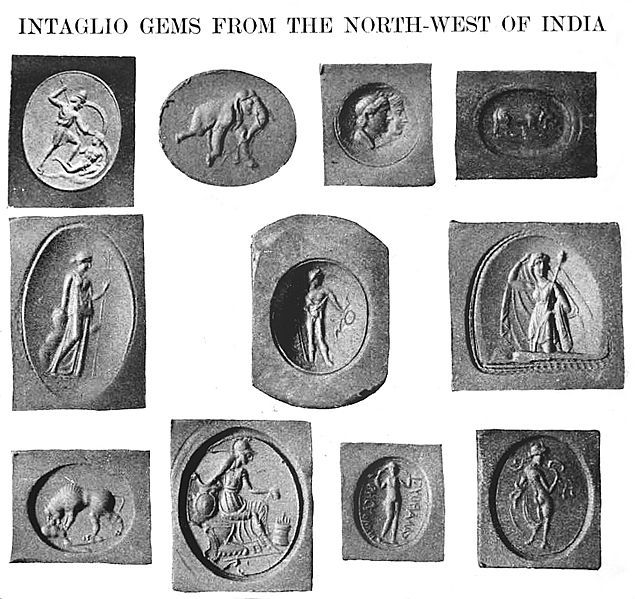Image: Intaglio gems from the northwest of India

Description: Imprints of intaglio gems from the northwest of India. "The engraved gems referred to are found in large numbers throughout the whole north-western area and are proved by the presence of legends in early Brahmi or Kharoshthi, as well as in Greek characters, to be the work of resident artists. Some typical specimens are illustrated in PL XXXIII, 88, a-k. The first is a cornelian intaglio from Akra in the Bannu district, of pure Hellenistic workmanship, designed and executed with a fine sense of composition and relief. Judging by the persistency with which it was repeated, the motif of the fighting warriors on this gem must have been almost as favourite a one in India as it was in Greece. Next to it and of about the same date is a remarkably spirited elephant cut on a pale sard. Then comes a jacinth (c), the jugate heads on which recall to mind the busts of Heliocles and Laodice on coins of Eucratides, though it is slightly later than they. The lion, also, on pale sard (d) is a fine example of delicate technique ; but in fig. e — a singularly beautiful sardoine — the style shows incipient signs of falling off", and in the three following specimens, a black garnet and two sards, we watch its slow and sure deterioration until the beginning of the Christian era. The next two gems of the series (i and j) are still more decadent. The treatment of the drapery and other details of the seated Athena in the former remind us irresistibly of coins struck about the time of Hermaeus, and we cannot be far wrong in assigning this gem to about 50 A.D., and the one which follows it to the close of the same century. The latter is a cornelian from the Hazara District, engraved with a figure of Aphrodite and bearing a legend in corrupt Greek characters. Finally, in fig. h, we have a representative of a large group of gems executed in a meretricious and distinctive style, which appears to have been fashionable in India in the first and second centuries A.D. and which, taken in conjunction with other facts, suggests that a strong wave of influence — due, perhaps, to Roman expansion — set in about that time from Asia Minor." From Cambridge History of India (Public Domain)
Title: Intaglio gems from the northwest of India
Credit: The Cambridge history of India 1922 [1]
Author: The Cambridge history of India 1922
Usage Terms: Public domain
License: Public domain
Attribution Required?: No
Image usage
The following page links to this image:

